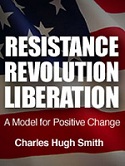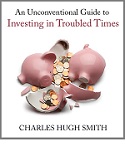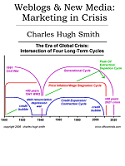

|

|
|||||||||||||
|
Our Dust Bowl Economy (November 20, 2012) When the present path cannot possibly lead to success, regardless of the labor and treasure poured into the effort, then risking the unknown by trying something different is the only way forward. The PBS series The Dust Bowl inspired an apt metaphor: ours is a dust bowl economy. What is the basis of the metaphor?
Simply this: those living in the dust bowl responded by doing more of what had failed rather than doing something different. Several key responses actively worsened the crisis: 1. In response to declining prices for wheat, farmers plowed up more marginal prairie land to plant even more wheat: the idea was to compensate for lower prices per bushel by growing more. We can anticipate the unintended consequence: bumper harvests further depressed prices, which fell from 95 cents a bushel to 25 cents a bushel (and stayed there). 2. Plowing up fragile prairie held together by native grasses exposed the soil to the winds, further feeding the dust storms. In our economy, debt is the marginal field that has been plowed up for brief exploitation and profit. In response to the drought of income and collateral that supports debt, the Federal Reserve, Congress and the Obama administration have actively made the crisis worse by doing more of what failed spectacularly: encouraging more debt with zero-interest rate policy (ZIRP), massive "socialized" subsidies of housing and mortgages, and so on. Just as in the dust bowl years, the occasional rain raises hopes of complete reversal. In our dust bowl economy, every "green shoot" of debt expansion, consumer confidence, builder confidence, retail sales, etc. is taken as "proof" that the "recovery" is "gaining steam" and the economy has fully reversed course from contraction to expansion. Then a few months later the "green shoots" whither because the fundamentals that enable more debt--household income and asset collateral--are both deteriorating. Income is down 8% from 2007, and median household net worth fell 38% from 2007 to 2010. (The data is skewed by the top 10% who own most of the individually owned stocks; as the stock market bounced back in 2010, so did the net worth of the top 10%, while the bottom 90% who have little exposure to stocks saw their housing-based net worth stabilize at post-bubble valuations.) Doing more of what failed spectacularly simply sets up even more spectacular failures in the future. Why do people persevere in doing more of what has failed? One reason is that we have been trained to think that perseverance in itself will magically lead to success. This overlooks the key determinant that the chosen path must be one that is capable of reaching success. Other characteristics are just as critical as perseverance: being flexible, adaptable and willing to learn and evolve. A second reason is the emotional appeal of hope. Since humans avoid the risk of radical change for the good reason that radical changes can go horribly wrong, it was easier to stay in the dust bowl and hope for a return of favorable weather and market prices than to accept that farming in the affected area was no longer feasible. Sadly, those who stayed based on hope for "better times" lost everything, while those who recognized the end of the previous era of prosperity left with some assets and an intact sense of self. The third reasons is a failure of imagination. This is a subject I have often addressed, for example in We Have No Other Choice (March 15, 2012), The Federal Reserve and the Pathology of Power (November 18, 2010) and Oversupply of Old Failed Ideas, Undersupply of New Pragmatic Ideas (July 16, 2010). We can sympathize with those faced with giving up a life they knew and that that had recently offered hope of enduring prosperity for an uncertain and unknown future trying something else.
But when the present path cannot possibly lead to success, regardless of the labor and
treasure poured into the effort, then risking the unknown by trying something different
is the only way forward.
Things are falling apart--that is obvious. But why are they falling
apart? The reasons are complex and global. Our economy and society have structural
problems that cannot be solved by adding debt to debt. We are becoming poorer, not
just from financial over-reach, but from fundamental forces that are not easy to identify
or understand. We will cover the five core reasons why things are falling apart:
 1. Debt and financialization
1. Debt and financialization
2. Crony capitalism and the elimination of accountability 3. Diminishing returns 4. Centralization 5. Technological, financial and demographic changes in our economy Complex systems weakened by diminishing returns collapse under their own weight and are replaced by systems that are simpler, faster and affordable. If we cling to the old ways, our system will disintegrate. If we want sustainable prosperity rather than collapse, we must embrace a new model that is Decentralized, Adaptive, Transparent and Accountable (DATA).
We are not powerless. Not accepting responsibility and being powerless are two sides of
the same coin: once we accept responsibility, we become powerful.
To receive a 20% discount on the print edition: $19.20 (retail $24), follow the link, open a Createspace account and enter discount code SJRGPLAB. (This is the only way I can offer a discount.) 



Please click on a book cover to read sample chapters
NOTE: gifts/contributions are acknowledged in the order received. Your name and email remain confidential and will not be given to any other individual, company or agency.
"This guy is THE leading visionary on reality.
He routinely discusses things which no one else has talked about, yet,
turn out to be quite relevant months later."
Or send him coins, stamps or quatloos via mail--please request P.O. Box address. Subscribers ($5/mo) and contributors of $50 or more this year will receive a weekly email of exclusive (though not necessarily coherent) musings and amusings. At readers' request, there is also a $10/month option. What subscribers are saying about the Musings (Musings samples here): The "unsubscribe" link is for when you find the usual drivel here insufferable.
All content, HTML coding, format design, design elements and images copyright © 2012 Charles Hugh Smith, All rights reserved in all media, unless otherwise credited or noted. I am honored if you link to this essay, or print a copy for your own use.
Terms of Service:
|
Add oftwominds.com |